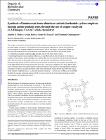| dc.contributor.author | GUNNLAUGSSON, THORFINNUR | |
| dc.date.accessioned | 2013-09-03T11:10:38Z | |
| dc.date.available | 2013-09-03T11:10:38Z | |
| dc.date.issued | 2012 | |
| dc.date.submitted | 2012 | en |
| dc.identifier.citation | Molloy, JK, Kotova, O, Peacock, RD, Gunnlaugsson, T, Synthesis of luminescent homo-dinuclear cationic lanthanide cyclen complexes bearing amide pendant arms through the use of copper catalysed (1,3-Huisgen, CuAAC) click chemistry, ORGANIC & BIOMOLECULAR CHEMISTRY, 10, 2, 2012, 314-322 | en |
| dc.identifier.issn | 1477-0520 | |
| dc.identifier.other | Y | |
| dc.identifier.uri | http://hdl.handle.net/2262/67316 | |
| dc.description | PUBLISHED | en |
| dc.description.abstract | The design and synthesis of dinuclear-lanthanide complexes possessing triazole-based bridges, formed by using copper catalysed 1,3-cycloaddition reactions between heptadentate alkyne functionalised cyclen europium or terbium complexes and di-azides (CuAAC reactions), are described. While this click reaction worked well for the formation of the homo-Eu(iii) and Tb(iii) bis-tri-arm cyclen N,N-dimethyl acetamide complexes, 2Eu and 2Tb, and for the homo-Eu(iii) chiral N-methylnaphthalene based complexes 3Eu (S,S,S) and 4Eu (R,R,R), the formation of the Eu(iii) complex of the primary amide analogue of 2, namely 1Eu, was not successful, clearly demonstrating the effect that the nature of the pendant arms has on this reaction. Furthermore, the click reactions between the free alkyne cyclen bis-derivatives (5-8) and the di-azide were unsuccessful, most likely due to the high affinity of the cyclen macrocycles for Cu(ii). The Eu(iii) complexes of 2-4 and 2Tb all gave rise to sensitised metal ion centred emission upon excitation of the triazole or the naphthalene antennae in methanol solution, and their hydration states were determined, which showed that while the Eu(iii) mono-nuclear complexes had q ~ 2, the click products all had q ~ 1. In the case of 3Eu (S,S,S) and 4Eu (R,R,R), the circular polarised emission (CPL) was also observed for both, demonstrating the chiral environment of the lanthanide centres. | en |
| dc.description.sponsorship | We would particularly like to thank Science Foundation Ire-
land (SFI) for RFP 2008 and 2009 funding, CSCB and TCD
(Postgraduate Scholarship to JKM), IRCSET (OK) for financial
support. We would especially like to thank Dr John E. O?Brien
and Dr Martin Feeney for assisting with NMR and MS analysis,
respectively and Dr Christophe Lincheneau for his assistance
during the course of this work | en |
| dc.format.extent | 314-322 | en |
| dc.language.iso | en | en |
| dc.relation.ispartofseries | ORGANIC &;BIOMOLECULAR CHEMISTRY | |
| dc.relation.ispartofseries | 10; | |
| dc.relation.ispartofseries | 2; | |
| dc.rights | Y | en |
| dc.subject | 1 ,3-cycloaddition reactions; Chiral environment; Click chemistry; Click reaction; Eu complexes; High affinity; Hydration state; Macrocycles; Methanol solution; Pendant arms; Primary amides; Terbium complex | en |
| dc.subject.lcsh | 1 ,3-cycloaddition reactions; Chiral environment; Click chemistry; Click reaction; Eu complexes; High affinity; Hydration state; Macrocycles; Methanol solution; Pendant arms; Primary amides; Terbium complex | en |
| dc.title | Synthesis of luminescent homo-dinuclear cationic lanthanide cyclen complexes bearing amide pendant arms through the use of copper catalysed (1,3-Huisgen, CuAAC) click chemistry | en |
| dc.type | Journal Article | en |
| dc.type.supercollection | scholarly_publications | en |
| dc.type.supercollection | refereed_publications | en |
| dc.identifier.peoplefinderurl | http://people.tcd.ie/gunnlaut | |
| dc.identifier.rssinternalid | 87585 | |
| dc.rights.ecaccessrights | OpenAccess | |




